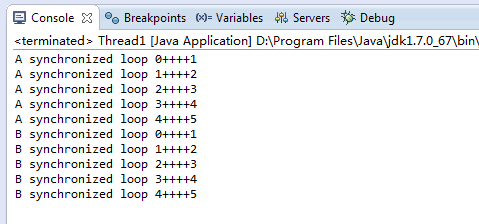先说同步方法。它究竟是锁定的当前对象,还是当前类
代码块1
package com.ssss;
public class Thread1 implements Runnable {
//public static Object o=new Object();
public void run() {
pt();
}
public synchronized void pt(){
int a=0;
//synchronized(o) {
for (int i = 0; i < 5; i++) {
a++;
try {
Thread.sleep(1000);
} catch (InterruptedException e) {
// TODO Auto-generated catch block
e.printStackTrace();
}
System.out.println(Thread.currentThread().getName() + " synchronized loop " + i + "++++" + a);
}
//}
}
public static void main(String[] args) {
Thread1 t1 = new Thread1();
Thread1 t2 = new Thread1();
Thread ta = new Thread(t1, "A");
Thread tb = new Thread(t2, "B");
ta.start();
tb.start();
}
}
打印出来的结果为
代码块2
看同步块
package com.ssss;
public class Thread1 implements Runnable {
public static Object o=new Object();
public void run() {
pt();
}
public void pt(){
int a=0;
synchronized(o) {
for (int i = 0; i < 5; i++) {
a++;
try {
Thread.sleep(1000);
} catch (InterruptedException e) {
// TODO Auto-generated catch block
e.printStackTrace();
}
System.out.println(Thread.currentThread().getName() + " synchronized loop " + i + "++++" + a);
}
}
}
public static void main(String[] args) {
Thread1 t1 = new Thread1();
Thread1 t2 = new Thread1();
Thread ta = new Thread(t1, "A");
Thread tb = new Thread(t2, "B");
ta.start();
tb.start();
}
}看打印序列
说明同步块能够锁定不论什么对象
就是说同步方法是锁定当前对象,同步方法块是能够锁定不论什么对象

